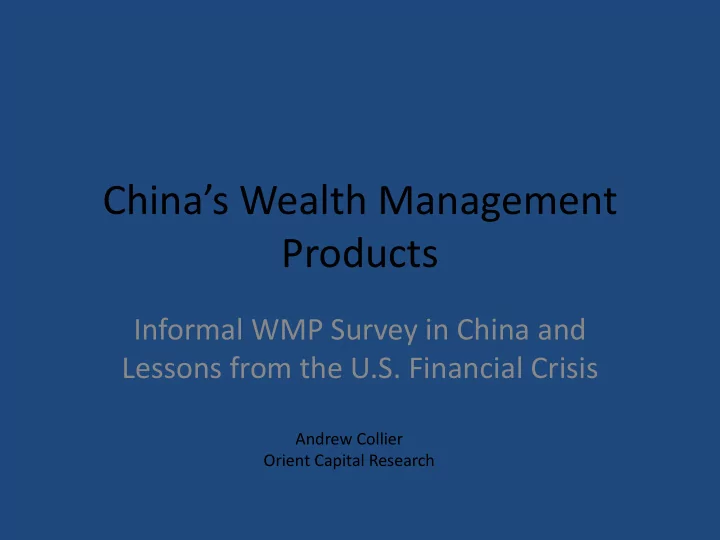

China’s Wealth Management Products Informal WMP Survey in China and Lessons from the U.S. Financial Crisis Andrew Collier Orient Capital Research
Practitioner • Peking U. Student. • Former investment banker Bear Stearns, CLSA. • Head of Bank of China International USA. • Now independent research analyst for U.S. investment funds.
Lesson One...
….Avoid Default.
WMP Survey • Survey of WMPs in 15 Cities in China • Data on 84 Products • Cross-section of lenders • “Snapshot” of the WMP Market
Cross-Section of Lenders • Majority of lenders we surveyed are trusts. • Cross-section of other lenders.
Loans: Large and Small • Large Loans (RMB1M +) = 64% • Small Loans (RMB1M - ) = 36% • Institutional versus Private/Small Business
Use of Capital • Paying off old debts – 37% • Working Capital - 13% • New Projects - 50%
Type of Investment • Property - 28% • Infrastructure – 25% • Financial Products – 22% • Small Business, etc. - 4% • Unknown – 21%
Variability in Interest Rates Interest rates ranged from 4.5% to 85.8%. Short term loans (24.8%) much higher than long-term (16.1%). Short- term loans are “bridge - loans” or working capital, while long-term loans are for hard assets. Long-term loans often LGFV related.
Shorter Durations • Anecdotally heard durations flattening. • Historically, 20% of loans were • for three years, 25% for two years, and less than 20% under six months. • 3M WMPs growing in popularity; 6 – 12M declinining (Fitch). • Rising Concerns over Risk.
Smaller Banks Increasing Share • Issuance from state banks declining (Fitch). • Local banks increasing participation. • More “rogue” lenders in the market.
Parallels with U.S. Financial Crisis • Principal/Agent Problem • Mispricing of Capital • Moral Hazard • Excess Securitization • Weak Asset Valuation • Maturity Mismatch
Principal vs Agent • Providers of capital must rely on financial “agents” • Diversification of financial products in U.S. – Mortgage Back Securities. – Securitization spread to other assets including autos, credit cards. – Rock’n Roll Bonds • Chinese financial intermediaries “Blindly” sell products that buyers don’t understand. – Nanjing Bridge Project – Stock Boiler Rooms. – Sellers offer interest rates but no projects.
Mispricing of Capital/Risk • Interest rates all over the map. • Banks say “What interest rate do you want?” Not “What risk can you manage?” • Due diligence on projects/loans is scarce.
Excess Securitization • Xian Developers – Prepay Tax. • Potential for capital calls throughout securitization chain. – Declining land values. • Correlation risk between asset classes – the theory of falling dominos.
Asset Valuation Weak • U.S. mortgage market – weak regulatory system. • PBOC has five working days to approve listing of trust contract; too little time. • Rating agencies monitor trust products “ongoing basis” rather than one -off rating.
Moral Hazard • “Greenspan Put” = “PBOC Put” • Excessive faith in financial regulators – PBOC Support for SOE Banks – Repeat of Recapitalization of Banks • Expectations for “Someone” to Recap Failed Loans • “The Government will always support the property market.”
Securitized Products – Financial “Orphans” • Securitization bridges gap between capital markets and illiquid credit assets. • Lack of clarity about issuer’s “fiduciary duty.” • No rule on recourse to trustee if asset declines in value – relevant to property market (similar to U.S. mortgage market).
Possible Solutions • Create quasi-governmental financial intermediary to provide liquidity like Fannie Mae/Freddie Mac. • Need laws to clarify legal recourse for borrowers. • Need Compliance Chain: Each leg of issuance is signed off with recourse instructions.
Recommend
More recommend